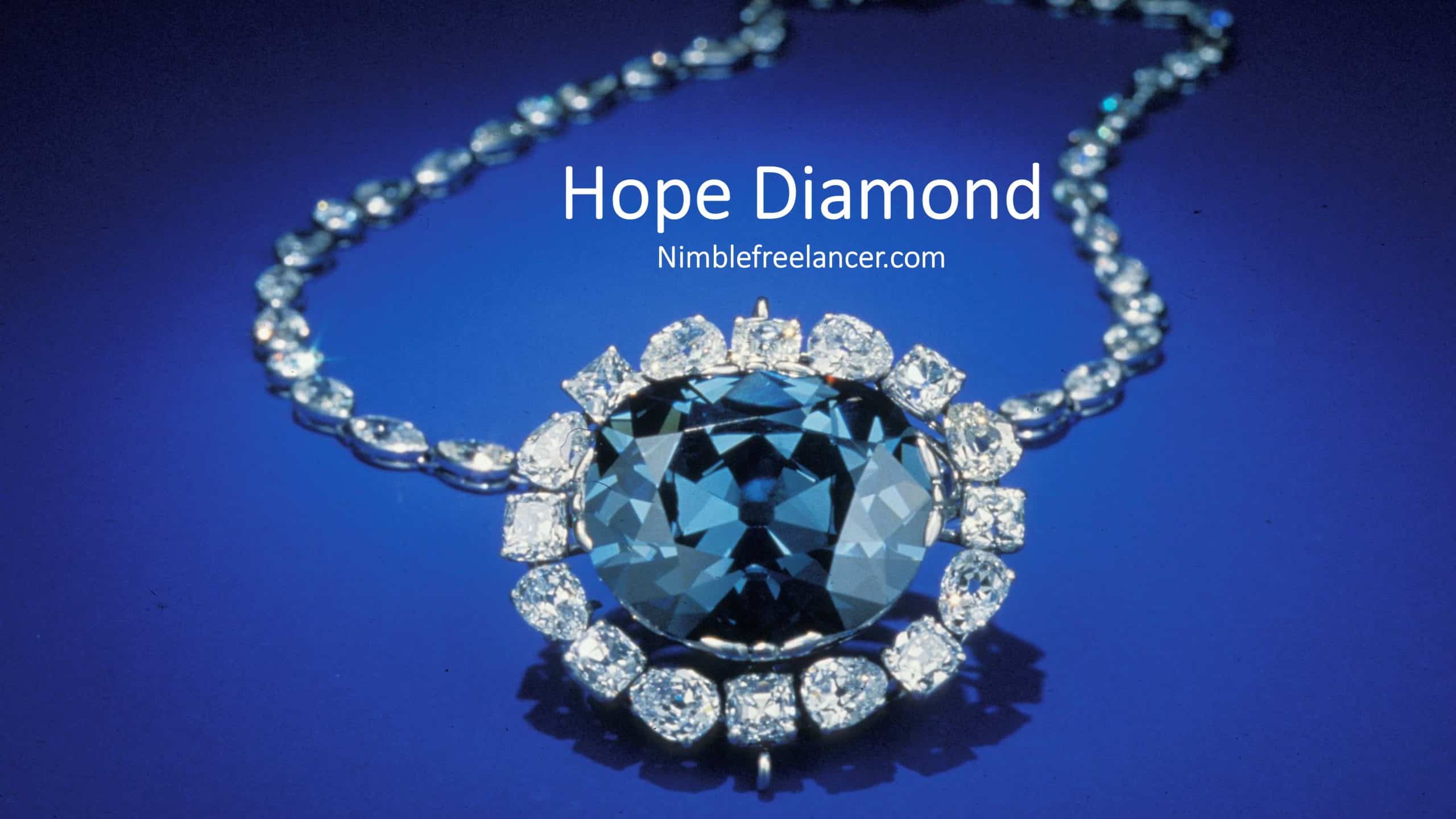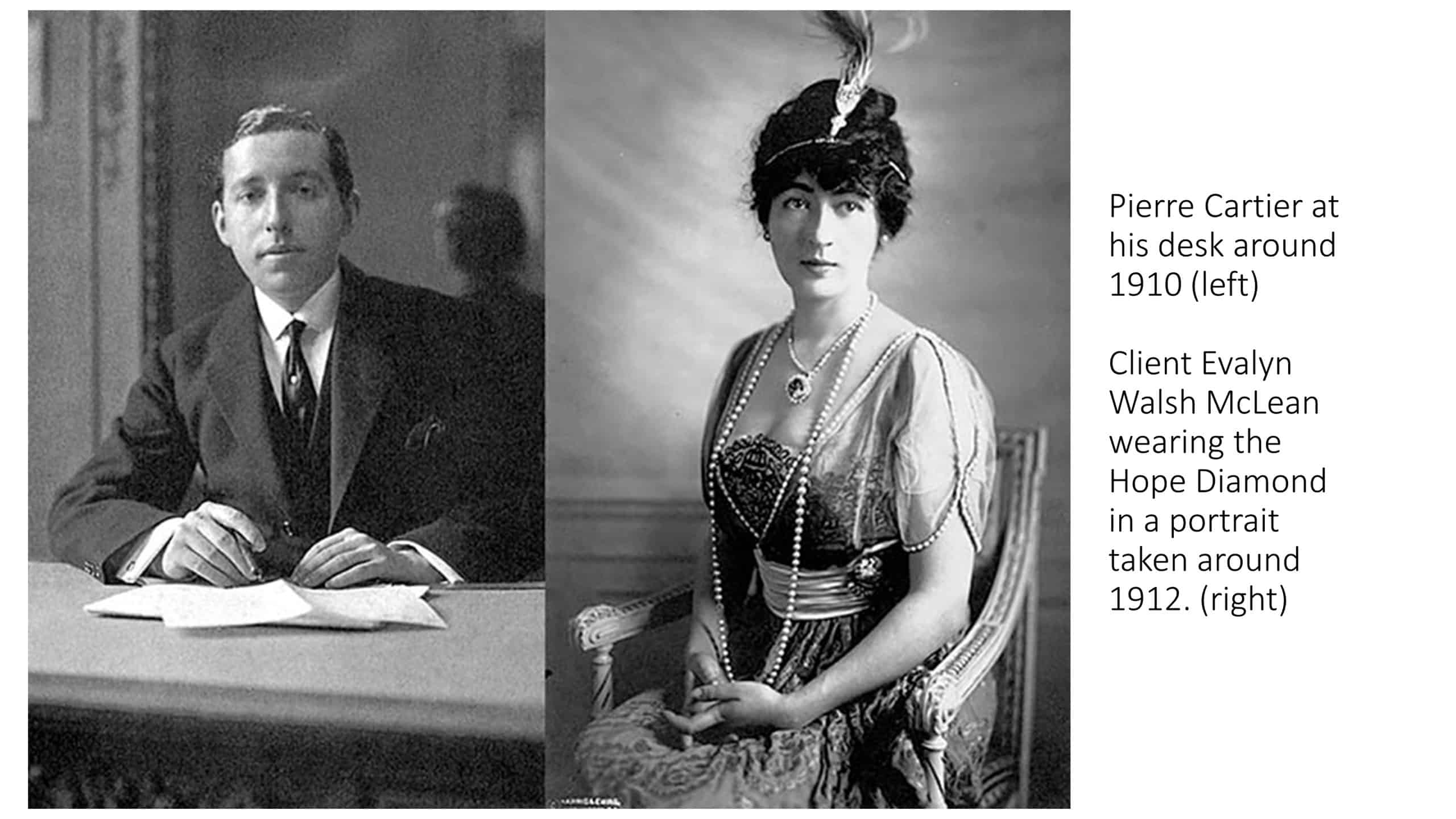The Hope Diamond, also known as the Le Bijou du Roi or the “King’s Jewel,” is one of the world’s most famous and sought-after diamonds. It is a rare and precious deep-blue diamond that has captivated people since its discovery in India in the 17th century.

The Hope Diamond is 45.52 carats and has a unique history that dates back to 1668 when French merchant Jean Baptiste Tavernier first purchased it from an Indian temple (to learn more about CT TW diamonds and carats, read our article). After Tavernier’s death, the diamond went to King Louis XIV, who had it cut into a 67.125-carat cushion-shaped blue diamond. Royals wore the stone, including Marie Antoinette and King George IV, who owned it until he died in 1830 before it passed onto his brother Henry Philip Hope, who named it after himself — thus giving us the name “Hope Diamond.”
The Hope Diamond is renowned for its size, color, and the legendary curse that allegedly follows anyone who owns this gemstone due to its tumultuous past. According to legend, all those who have ever come into contact with this diamond have been struck down by unexpected tragedy or death – leading some to believe there is something special about this stone beyond its apparent beauty and rarity.
Many studies have been conducted to determine if this phenomenon is simply superstition or if there are any scientific explanations behind these events; however, nothing conclusive has been found, making this one of life’s great mysteries! The diamond has become as celebrity as any of its former owners with iconic appearances at events like Lady Gaga’s 2016 Academy Awards performance, where she was seen wearing a replica of the Hope Diamond necklace during her song “Til It Happens To You.” Overall, many consider it one of the world’s most valuable gems and an enigmatic signifier of power and beauty throughout history – leaving us to wonder what stories lie within its depths, still waiting to be discovered!
Hope Diamond history
The Hope Diamond is one of the world’s most famous and valuable diamonds, with a rich and storied history. The diamond is believed to have originated in India, in the Kollur mine of the Guntur district of Andhra Pradesh, which was then part of the Golconda kingdom. This origin theory is based on remarks written by French gem merchant Jean-Baptiste Tavernier 1666, who was among the first Europeans to visit India and purchase precious gems, including diamonds.
The origins of the Hope Diamond can be traced back even further: according to Hindu mythology, it began as a large blue diamond owned by a Hindu god named Sita (a consort of Lord Rama). The god had gifted it to King Krishna centuries before Tavernier wrote about obtaining it from India. After numerous owners over many generations, the diamond eventually made its way into the possession of Tavernier’s gem trading business.
After being obtained by Tavernier, the diamond changed hands multiple times until it was passed down to King Louis XIV in 1668. It was then set into an impressive crown for his wife Marie Antoinette’s coronation ceremony. Still, it was lost during the revolution when it was stolen along with other treasures from France’s royal family.
After this event, its location remained unknown until 1812, when a businessman named Daniel Eliason purchased what he believed to be ordinary 45-carat diamonds and had them cut down to 28 carats. This is currently known as “the French Blue,” which would later become one of two stones that make up the Hope Diamond (the other being a 17-carat stone obtained by Henry Philip Hope).
Hope Diamond 1912. was sold by Pierre Cartier
1912, the Hope Diamond was sold to an American couple named Ned and Evalyn Walsh McLean. The sale resulted from two years of work by French jeweler Pierre Cartier, who had purchased the diamond in Paris just a few years prior.
1911 Pierre Cartier sold the Hope Diamond to New York socialite Evalyn Walsh McLean for $180,000. She wore it on many occasions, although she suffered several misfortunes, such as her husband’s bankruptcy and their son’s death shortly before she died in 1947. The gem remained with her family until 1949, when Harry Winston donated it to the Smithsonian Institution, where it remains today on display at their Natural History Museum in Washington D.C.
The story began when Cartier spotted the brilliant blue diamond at a London auction house in 1908. He recognized its worth immediately and placed a winning bid despite lacking sufficient funds to cover the purchase price. Afterward, he set off on a mission to find buyers wealthy enough to meet his asking price and with enough curiosity to appreciate its unique qualities.
When it came to finding such buyers, Pierre didn’t have far to look: He quickly identified Evalyn and Ned McLean as potential purchasers thanks to their affection for Cartier’s previous diamonds—namely, the 94.8-carat Star of East that they had bought while on their honeymoon in Paris two years earlier.
It wasn’t long before Pierre got his chance; in 1910, while vacationing in Paris again, the McLeans were presented with Pierre’s remarkable narrative about the Hope Diamond – including its renowned curse that brought bad luck upon those who owned it. Captivated by the tales of its extraordinary provenance, Evalyn expressed her interest almost immediately; this marked both her and Ned’s entry into what would become an ongoing affair with Cartier jewelry that spanned from 1910 until they died in 1941 and 1947, respectively.
With Evalyn’s excitement as motivation, negotiations between Pierre and the McLeans began shortly after that, resulting in an agreement signed in 1912 for just under $180,000 (nearly $4 million today). It remains unknown exactly how much Ned knew about the stone’s cursed past at this time; however, for many years after obtaining it, he often used it as a conversation starter among guests at his parties – constantly pausing before revealing what lay beneath its deep-blue depths – allowing glimpses into yet another dimension of his unique personality.
The legacy of this transaction continues throughout history; not only did it see one of nature’s precious treasures go from a London auction house to being featured as part of The Smithsonian Museum’s grand collection, but it also cemented Cartier’s place in history as one of France’s foremost jewelry designers—able to create not only exquisite pieces but also bring imaginative stories alive for us all to share.

In 1949, Harry Winston purchased it from George Gordon Hope; Winston later donated it to the Smithsonian Institution, where visitors can gaze upon this fascinating gemstone today.
There are several theories surrounding why Hindus consider this particular stone sacred—one popular belief suggests that its curse comes from Sita’s curse on any man who possessed her gift without good intentions or respect; another indicates that because blue represents infinity and intelligence, it makes this particular stone special and unique while others speculate that its color symbolizes death or danger due to its blue appearance.
Despite its rich history, modern science has revealed much about this mysterious gem through chemical analysis testing—it is composed primarily of carbon atoms linked together in a three-dimensional network, which gives it strength and hardness but also makes it highly susceptible to fracture if struck too hard or exposed to extreme temperature variations; meanwhile its color is caused by trace amounts of boron atoms trapped within these carbon lattices which absorb light waves causing them to appear blue – although some experts believe there may be other elements involved in creating its distinctive hue. Whatever scientific secrets lie beneath this beautiful jewel are still unknown as researchers continue investigating what makes it unique – though love for such grandeur will never die out!
Hope Diamond’s geological history
The Hope Diamond’s geological history dates back more than 1.1 billion years. It was formed deep in the EartEarth’stle, where extreme temperatures and pressure caused EartEarth’sbon atoms to bond with great strength. Over the millennia, these bonded carbon atoms became what is now known as the Hope Diamond. This unique diamond contains trace amounts of boron mixed into its crystal structure, giving it its rare blue color.
See below my image of the Hope diamond color:

The origin story of the Hope Diamond can be traced back to the kimberlite deposits. Kimberlite is an ultramafic igneous rock that forms in deep parts of the Earth’s crust and can contain diamonds. The rock magma earth by kimberlite eruptions brings resident minerals to the surface, including diamonds like the Hope Diamond. After millions of years under pressure and heat in the Earth’s crust, these minerals form crystals from deep in the Earth’s crust through volcanic eruptions or intense earthquakes.
Once extracted from kimberlite deposits, geologists examine each diamond for its size, shape, color, and clarity to determine its value. The Hope Diamond was one such diamond deemed valuable due to its unique hue and sought after by many collectors throughout its history. The rare blue color of this diamond is caused by trace amounts of boron mixed with its carbon structure, which causes a subtle shift in wavelength when light reflects off it.
After refining this unique diamond from its naturally occurring state, experts used advanced technology such as laser inscription and ultraviolet fluorescence tests to analyze and certify its authenticity before it was put up for sale or display. Such technologies allow for a detailed microscopic examination, which reveals special features about gemstones like the Hope Diamond that would otherwise be concealed beneath their polished surfaces.
Today, this treasured gem resides at Washington DC’s Smithsonian Museum, where visitors can marvel at its beauty while learning about its fascinating geological origins, discovered billions of years ago at the eartEarth’sths. Through studies on Cellular composition and isotopic analysis, scientists continue unraveling more secrets about how this remarkable gem existed on our planet so long ago.
To learn more about diamonds, please read our articles:
Do Lab-Grown Diamonds Hold Their Value?
How to Tell How Many Carats a Diamond Is?
How Much is 1 Carat Diamond Worth?
How Much is a 3-Carat Diamond Ring?
How Many Carats is the Hope Diamond?
What does 1/10 CT TW Diamond Mean?
- Facebook Ads to Get Followers! - December 27, 2024
- ClickUp vs. Slack - December 20, 2024
- Mastering E-Commerce Analytics: A Blueprint for Success






